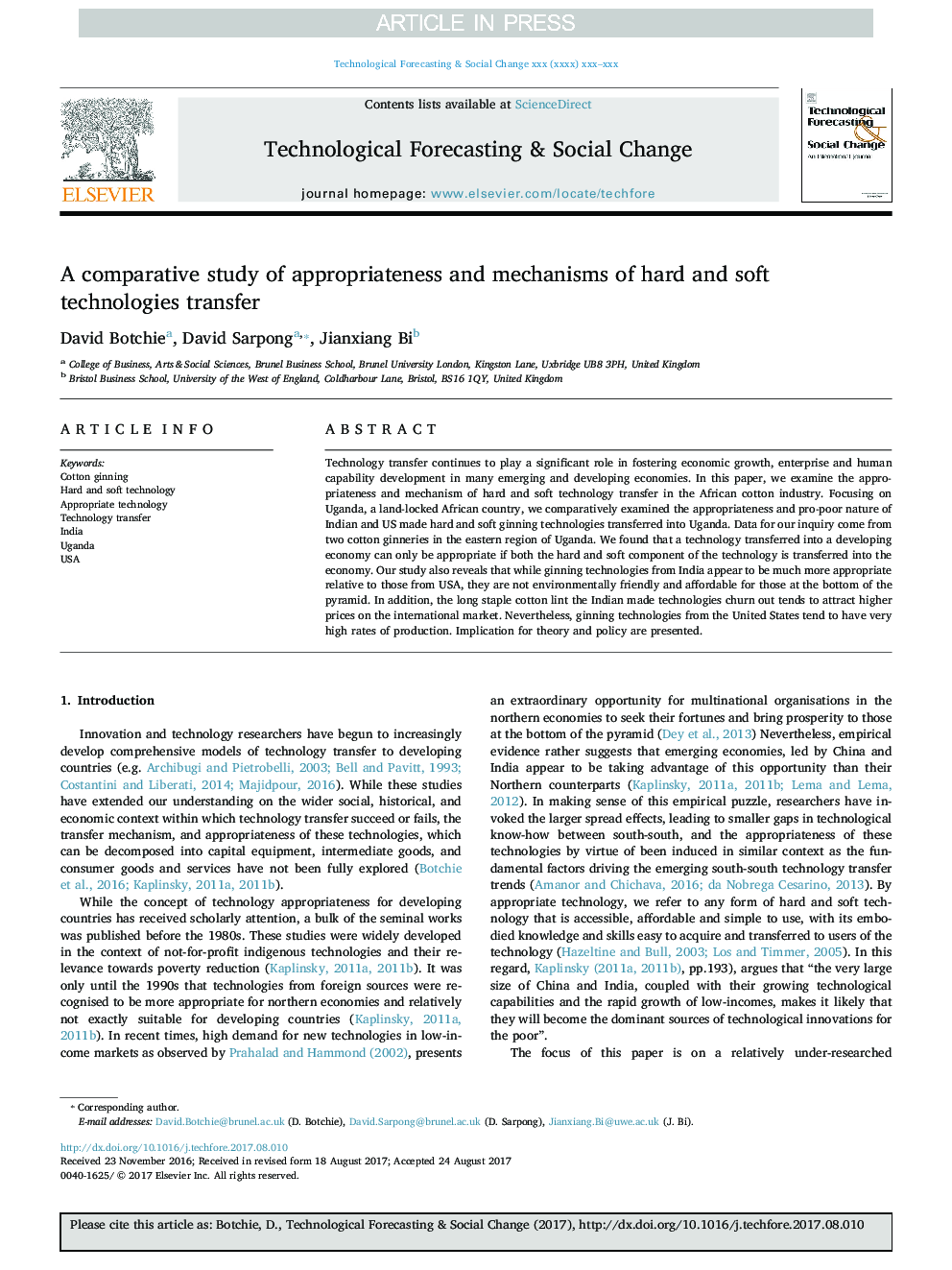| کد مقاله | کد نشریه | سال انتشار | مقاله انگلیسی | نسخه تمام متن |
|---|---|---|---|---|
| 7255390 | 1472370 | 2018 | 13 صفحه PDF | دانلود رایگان |
عنوان انگلیسی مقاله ISI
A comparative study of appropriateness and mechanisms of hard and soft technologies transfer
ترجمه فارسی عنوان
یک مطالعه تطبیقی مناسب و مکانیزم انتقال تکنولوژی سخت و نرم
دانلود مقاله + سفارش ترجمه
دانلود مقاله ISI انگلیسی
رایگان برای ایرانیان
کلمات کلیدی
پیراهن نخی، تکنولوژی سخت و نرم، تکنولوژی مناسب، انتقال فناوری، هند، اوگاندا، ایالات متحده آمریکا،
ترجمه چکیده
انتقال فناوری همچنان نقش مهمی در رشد اقتصادی، توسعه سازمانی و توانایی انسانی در بسیاری از اقتصادهای نوظهور و در حال توسعه دارد. در این مقاله، ما به بررسی تناسب و مکانیزم انتقال تکنولوژی سخت و نرم در صنعت پنبه آفریقایی می پردازیم. با تمرکز بر اوگاندا، یک کشور آفریقایی محاصره شده، ما نسبتا مورد بررسی قرار گرفتیم که سازگاری و معیار طرفداران هند و ایالات متحده، تکنولوژی های سخت افزاری و نرم افزاری را به اوگاندا منتقل کرد. داده های مربوط به تحقیق ما از دو محصول پنبه ای در منطقه شرقی اوگاندا است. ما دریافتیم که فناوری انتقال یافته به یک اقتصاد در حال توسعه تنها در صورتی قابل قبول است که هر دو جزء سخت و نرم از فناوری به اقتصاد منتقل شوند. مطالعه ما همچنین نشان می دهد که در حالیکه فن آوری های هند از هند به نظر می رسد بسیار مناسب تر از آنهایی است که از ایالات متحده آمریکا هستند، برای کسانی که در پایین هرم قرار دارند، محیط زیست دوستانه و مقرون به صرفه نیست. علاوه بر این، پنبه ای با طول عمیق که از فن آوری های هند ساخته شده است، تمایل به جذب قیمت های بالاتر در بازار بین المللی دارد. با این وجود، فناوری های برقی از ایالات متحده به میزان بسیار بالایی تولید می کنند. اعمال تئوری و سیاست ارائه شده است.
موضوعات مرتبط
علوم انسانی و اجتماعی
مدیریت، کسب و کار و حسابداری
کسب و کار و مدیریت بین المللی
چکیده انگلیسی
Technology transfer continues to play a significant role in fostering economic growth, enterprise and human capability development in many emerging and developing economies. In this paper, we examine the appropriateness and mechanism of hard and soft technology transfer in the African cotton industry. Focusing on Uganda, a land-locked African country, we comparatively examined the appropriateness and pro-poor nature of Indian and US made hard and soft ginning technologies transferred into Uganda. Data for our inquiry come from two cotton ginneries in the eastern region of Uganda. We found that a technology transferred into a developing economy can only be appropriate if both the hard and soft component of the technology is transferred into the economy. Our study also reveals that while ginning technologies from India appear to be much more appropriate relative to those from USA, they are not environmentally friendly and affordable for those at the bottom of the pyramid. In addition, the long staple cotton lint the Indian made technologies churn out tends to attract higher prices on the international market. Nevertheless, ginning technologies from the United States tend to have very high rates of production. Implication for theory and policy are presented.
ناشر
Database: Elsevier - ScienceDirect (ساینس دایرکت)
Journal: Technological Forecasting and Social Change - Volume 131, June 2018, Pages 214-226
Journal: Technological Forecasting and Social Change - Volume 131, June 2018, Pages 214-226
نویسندگان
David Botchie, David Sarpong, Jianxiang Bi,
